Press Information on Attendance
Please send mail to iswc2003-press@cc.gatech.edu to register for a press pass. Television crews may find that the exhibits, demonstrations, and posters on late Wednesday afternoon and evening provide the best visuals of the conference, and these sessions in the program will allow time for interviews. The gadget show on Thursday is an informal presentation of new technologies and is often a good source of still images.
Flash photography and television crews will not be allowed during the academic paper sessions so as not to disrupt the presentations.
Press Release
In the past six months, the stocks of publicly traded wearable computer companies have risen 100-400%! In Europe and Asia, funding for research in wearable computers has increased substantially, and wearable devices are becoming mainstream. Cellular phones, wristwatches, and MP3 players from major manufacturers are now reaching computational functionality that was once only demonstrated in research laboratories. Specialized wearable computers are addressing niche markets in inventory control, package routing, and even parking ticket issuing by the New York police. If wearable computing is becoming a reality today, where will the future lead?
The IEEE International Symposium on Wearable Computers (ISWC) remains at the forefront of mobile computing technology. Academics, industrialists, military and government officials, and the fashion industry will gather for three days October 21-23 in White Plains, NY to discuss the latest research results, demonstrate their latest gadgets, and exhibit current products in the seventh annual convocation of the conference.
This year, IBM's T J Watson Research Center is playing a significant role in organizing the conference, and the conference's demonstration and poster session will be held in IBM's research buildings. IBM will open their Industry Solutions Laboratory for tours during the Wednesday poster and demonstration session. Expect to see the most recent innovations from IBM, which in the past have included the IBM Linux Wrist Watch - a fully functional Linux workstation that can be worn on the wrist.
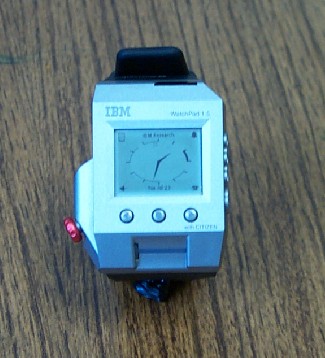
Linux Watchpad. Image courtesy of IBM Research.
Examples of ISWC papers and demonstrations this year include the ASL OneWay (an American Sign Language to English Translator) and a system for authoring 3D hypermedia for wearable augmented reality.
The ASL OneWay is a potential tool for the Deaf community to communicate with the hearing. The signer wears a set of sensors in a hat and a wristwatch-sized device on each hand. The user signs a phrase, such as "which way to the bathroom?" The system recognizes the sign and determines the top English phrases which most closely match the signed phrase. These candidate phrases are shown to the user in a head-up display. The user selects the closest phrase, and that phrase is spoken through a speaker in the hat. In general, the phrases are selected so as to require simple responses from the hearing participant, such as nodding yes or no or pointing directions. In this manner, the system does not also have to translate English speech to sign.

Helene Brashear and Thad Starner demonstrate a prototype mobile sign
language recognizer under development at Georgia
Tech. Image courtesy of Georgia Institute of Technology. Larger image.
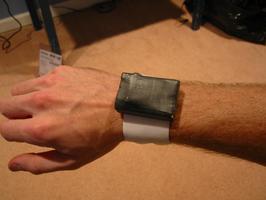
Bluetooth-enabled accelerometers for recognizing gesture. Image
courtesy of Georgia Institute of Technology.
Augmented reality can be used for a wide range of applications, from instruction manuals to games. The following images are of "situated documentaries"---hypermedia news stories that are integrated with the physical environment in which the events that they report took place. For example, Columbia University researchers have created an augmented reality which displays the history of the Columbia campus as the user traverses it.
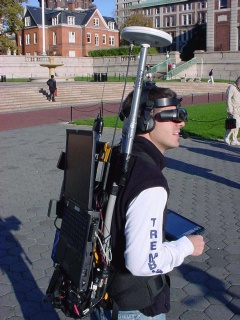
Research prototype of an augmented reality system
that displays information on the history of Columbia University's
campus. (c) 2002 Computer Graphics and User Interfaces Lab, Columbia
University. Larger image.
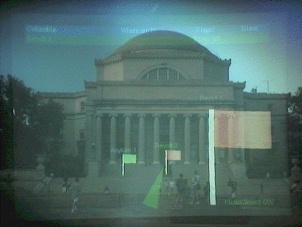
Virtual flags overlaid on the physical world indicate links to
content about Columbia University's past. (c) 1999 Tobias Hoellerer,
Steve Feiner, and John Pavlik, Computer Graphics and User Interfaces
Lab, Columbia University. Larger image.
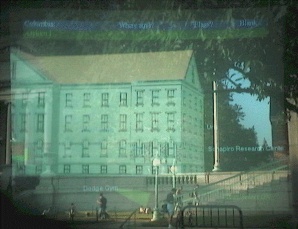
Columbia's AR system overlays a model of an asylum that used to occupy
this location before the university campus. (c) 1999 Tobias Hoellerer,
Steve Feiner, and John Pavlik, Computer Graphics and User Interfaces
Lab, Columbia University. Larger image.
![[iswc logo]](wearman-small.gif)